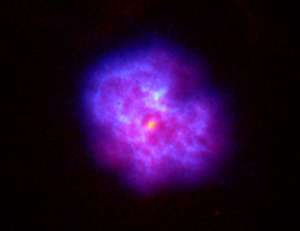The Sun and Other Stars
- Page ID
- 185340
|
Our Sun is much closer to us than any other star. Light from the Sun takes about eight minutes to reach Earth, but the light from the next nearest star takes a several years to reach us. Stars are distant Suns, but so far away they look like points of light. They are giant balls of hot gas, just like our Sun. They are also like people. They are born, live through a long middle age, and finally die. Some stars are alone, like our Sun, and others have a constant companion, usually another star. Stars also change as they age. These changes take place over millions and billions of years so we don't notice them. Stars are born out of huge clouds of gas and dust that fill some of the space between the stars. As it enters its "middle-age" it shines steadily, powered by the hydrogen fusion in is center. All stars, no matter how large they are, eventually run out of hydrogen "fuel" at their centers, and begin to die.
|
|
|
Our Sun is now about halfway through its middle age. It will continue to give us light and heat for another 5 billion years. How long a star lasts depends on how big it is. The biggest stars live fast (meaning hot) and die young by blowing themselves to bits (Supernova) . Smaller stars live calmly for hundreds of millions of years and die much more quietly. Stars all seem to be made up of the same elements that are found on Earth, even though they can be different sizes, temperatures, and ages. Our Sun is an average-size star, maybe a little smaller than most stars. Stars the size of our Sun are known as Dwarf Stars. The largest stars can be 10 times larger across then the Sun. These are called Giant or SuperGiant stars. The very smallest stars are not much bigger than the planet Jupiter. They can all be different colors. Their color depends on their temperature, how hot they are. The coolest stars are nearly 500 degrees, while the hottest stars can reach 90,000 degrees. Cool stars appear red, and hot stars look bluish-white. |
Information from: http://nfo.edu/
Images from: https://public.nrao.edu/



